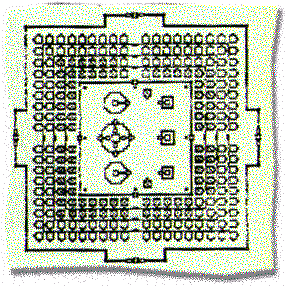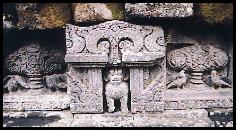

Built from 835 to 856,
it contains the remainders of king of Mataram Balitung which claimed to be a
reincarnation of Shiva. This complex was built by the hindu dynasty Sanjaya,
which had just reunified all the center of Java, beside the great Buddhist complex
of Candi Sewu to compete with the other religion and
to bring the population to the hindouism. These examples of "cohabitation"
will be very numerous. Candi Prambanan, itself, will
use in its architecture some Buddhist elements as the 200 small bells which
surround the temple of Shiva on its various levels.
This complex was located close to the Opak river, which was even diverted in order to ensure a better irrigation of the rice plantations. Nevertheless, the occasional overflows of Opak and other rivers of the plain of Prambanan were badly controlled at such point that an inscription of 856 speaks about a flood which was such, that a good part of the site was carried and the large temple itself damaged. It is perhaps this difficulty of controlling the course of the rivers in this plain which pushed the kingdoms of central Java to be settled more in the east. Destroyed after many earthquakes, the rebuilding of the three principal temples, devoted to Brahma, Vishnu and Shiva began in 1937 and was completed in 1987.
In
front, are the three small buildings intended to accomodate the
mountings of the gods. One sees there in particular the bull of
Shiva Nandi with on his sides, plated on the wall of the bottom,
the small statues of Chandra and Surya, i.e. the Moon and the
Sun. Some think that the two other temples did not contain
mountings of Brahma and Vishnu, but another statue of Shiva and a
lingam.

On
the edges north and south are two constructions, similar to the
other large buildings, but much smaller, 16 m in height, and
which are called Candi Apit. 224
templions, called Candi Perwara, divided
into four square rows circumscribe the eight principal monuments.
Lastly, eight small structures of four meters in height, called Candi
Kelir, ends the complex according to the eight
directions. The whole of the complex is marked by a square wall
of 240 m on each side.
Candi
Prambanan repeat in a gigantic format the principle
inaugurated with Gegong Songo fifty years before.
Here are the three principal temples such as they appear on the terrace: from left to right, Candi Brahma, Candi Shiva, Candi Vishnu.
Located
at the south of Candi Shiva, it measures
on the ground 20 m X 20 m for a height of 37 m. A flight of steps
gives access to the cella which contains a statue in foot of the
god, with four heads and four arms. A terrace makes the turn of
the building. On the interior face of the balustrade, which is
surmounted by many small stuppas, one can follow the continuation
and the end of the low-reliefs illustrating Ramayana of which the
first part is on the temple devoted to Shiva.
With its 50 m top the temple of Shiva will be during thousand years the highest monument of Java. It is one of the rare temples to be built with large-sized stones as some weigh up to 600 kg.
This building has a dimension on the ground of 34 m X 34 m.
A
first flight of stairs allows to reach an opened terrace, from
where start a second flight of stairs leading to the cellas. On
both sides departure of this second series of steps, two small
staircases end downwards in a terrace whose external edge is
characterized on its internal face by an exceptional series of
carved panels representing the episodes of Ramayana.
These panels make not only
the turn of the temple, but they will be completed in the close temple, the
one devoted to Brahma. On the wall of the temple of Shiva, facing the illustrations
of Ramayana, are 24 panels representing divine characters. There are initially
the eight gods guards of spaces, that is to say starting from the East: Indra,
Agni, Yama, Nairrta, Varuna, Vayu, Kuvera, and Isana. Each one of them is represented
twice. The two identical images are separated by eight other divinities who
would be: Brhaspati, Hanuman, Brahmanaspati, Surya, Karttikeya, Kama, Isvakarman,
et Narada.
Les The cellas, five here, facing the four axes, contain superb images of the four usual divinities, Agastya, Ganesha, and Durga on the South, West, and North side, plus Shiva Mahadeva in the center. The cell on the East side contains the statues of the two guards of the door of Shiva, Nadishvara et Mahakala.
Durga is more known here under the name of Loro Jonggrang ("the slim virgin"), which, in fact, ended up giving its name to the temple.
Loro
Jonggrang, according to the legend, was the girl of Ratu Boko
(the eternal lord ). Refusing the advances of a giant, she defy
him to build a temple in one night. Whereas he had almost
finished before the rising of the day, she made beat rice
announcing the end of the night prematurely. The giant, made
furious, then transformed her into a stone statue.
Candi
Vishnu located at the north of Candi Lara
Jonggrang is the twin brother of Candi Brahma
: same architecture and same dimensions. In the cella throne a
statue of the god. The principal difference and the principal
interest of the building are in the low-reliefs which decorate
the interior face of the balustrade of the platform and which are
an illustration of Krishnayana or the
adventures of Krishna, avatara of Vishnu,
and his brother Balarama.

Since
Candi Prambanan is surrounded by monuments
intended for the worship of Buddhism, certain researchers put
forth the assumption that this temple could, him also, being
intended for the same worship. In this case there, the three
large Hindu gods, Brahma, Vishnou, and Shiva, would be headed by
the Buddha Vairochana, the great solar Buddha, the same one as
the one who occupies the Holy of Holies of Candi Sewu,
just at side. It should be noted that the vihana (mounting)
of Vairochana, is a lion, perhaps the one of the "Prambanan
motif".
![]()